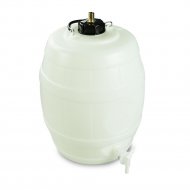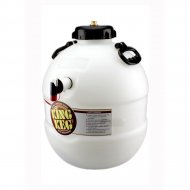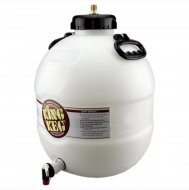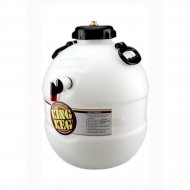Sign up to the Brew Mart newsletter for the latest news, offers & more
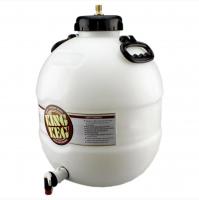
Home Brew Beer Barrels
Plastic Barrels
Food grade plastic home brew pressure storage barrels with screw lid for the beer brewing enthusiast starting with the 2-gallon beer barrel size, the ever popular King Keg
Plastic storage beer barrels with screw lid both small and large, plus plastic wine barrels, all are great for parties.
Learn how to use the S30 CO 2 gas cylinder
Homebrew Barrels
There are several different barrel types. They vary significantly, from traditional oak barrels to modern stainless steel barrels. We will be discussing pressure barrels for homebrew. Therefore oak barrels will not be covered in this article.
There are two main types of homebrew pressure barrels, plastic barrels like the economy barrels and king keg barrels and stainless steel barrels like the Cornelius kegs and the Brew Dog Kegs.
Plastic Beer Barrels
A good quality sturdy food grade plastic pressure barrel is an established way of serving homebrewed beer from the tap. The white plastic makes it easy to see how much beer remains in the barrel.
- Strong food-grade plastic
- Carrying handle
- Two sizes 1 gallon or 5 gallon
- Top tap or bottom tap
- A choice of barrel caps
- Pin or pressure valve
Wine Barrels
Buy food grade plastic see-through wine barrels with a tap attached for ease of use.
As the wine is drawn off, the wine barrel walls collapse. No air is allowed into the chamber, which keeps the wine in tip-top condition for you to drink and enjoy.
These wine barrels come in a box for easy storage. The boxes keep the wine barrels stable as the sides collapse during use.
F.A.Q.
Do we have to drink the beer in the beer barrel simultaneously, or can we drink it at intervals?
Answer:
Once your beer is in a pressure barrel, it usually keeps for quite a while. You can store your beer in your barrel and use the tap to draw off pints as you need them. The bottom may be full of yeast. (The term is scraping the bottom of the barrel). Consequently, make sure that you leave the last inch in the barrel. You only need a gas bottle to screw in the top of the pressure barrel to force all the beer out. When you remove the beer, it creates a bit of a vacuum. Sometimes, the vacuum can stop the beer from coming out. But no - you don’t have to drink it all in one go unless you wish to of course.
Barrel Maintenance
The essential maintenance of the barrel is similar for both types.
After use, rinse the leftover yeast, beer and foam from all areas, including the lid, floats, taps and valves. If there is any dried-on residue, you may need hot water with some V.W.P. cleaner steriliser.
When cleaning the inside of a barrel, be sure to use a cotton cloth or nylon brushes. Please DO NOT use any abrasive materials, as they will damage the inner surface of the plastic barrel and provide anchor points for bacteria and other nasties. It also makes it significantly harder to clean and sterilise effectively for all subsequent attempts to use the barrel.
Once clean, dry the barrel and visually inspect all washers, repair or replace any damaged washers, reapply any lubricants and check the tightness of all fittings. Finally, remember to sterilise the barrel immediately before re-using.
Please watch our video on valve maintenance for further information.
Pressure Barrels and Kegs are a great way to condition and store your homebrewed beer, lager, and real ales. It is much quicker and easier than bottling. There are many different barrels available, allowing you to choose the one that suits your needs. Using a keg means you can dispense your beer just like in pubs.
Use of Pressure Barrels and Casks
Once your beer has fermented, you will need something to store and from which to serve the beer. There are many options available to home brewers, each with pros and cons. This article will explain how to use pressure barrels, cover the most significant benefits of using barrels, and help you get the best out of them.
Barrels are well suited for all beer types. It is, after all, the preferred method for commercial brewers. What is different is how they are carbonated.
In most commercial situations, the beer is flat when in the barrel. However, the introduction of carbon dioxide happens at the time of serving. In homebrewing, the beer is self carbonated. (Self carbonation of a beer is essential to qualify as a real ale.) Pressurisation or carbonation is one of the main issues to be on top of when using barrels. Like most things in homebrew, carbonation is not tricky. It just needs regular attention. If you want to know more about this, look at our articles and videos on pressurising a barrel.
Barrels are easy to clean and sterilise. Beer can be syphoned directly from the fermenter into the barrel. Sugar is added for secondary fermentation, pressurising the barrel and providing light carbonation (or condition). Secondary fermentation is also known as priming. Ensure that the barrel is stored in a cool area away from direct sunlight. When stored well, beer can keep in the barrel for months, even years.
Homebrew Barrels come in 2 main types.
- The more economical barrel with a tap at the bottom and a 2" screwcap
- The more expensive, King Keg style barrels have 4" screw caps. They are available with either a top tap or bottom tap.
The king kegs are easier to clean as you can get your hand inside them. If you need to store the barrel on the floor, the top tap version will better suit this.
Both versions will probably require the addition co2 as you consume the beer. As the level of the beer goes down in the barrel, a void will replace it. No air can enter the barrel; however, the beer will continue to give off some co2, filling this void.
If the beer level drops too quickly, the co2 will not be able to replace the void quickly enough, causing a vacuum, and the pressure in the barrel will drop.
If this happens, you will need to maintain the pressure by adding co2 to fill the void.
The level of co2 required by the barrel depends on many factors. You can expect the need to top up co2 on a forty-pint barrel two or three times.
There are two ways that co2 can be added and your preferred way with determining the type of valve you use.
- S30 Valve - The S30 system uses larger C02 bottles, which is cost-effective. The initial purchase includes the cost of the bottle. For all subsequent purchases, you return the empty bottle in exchange for a full one only pay for the gas. These CO2 bottles work with the S30 valves, and you add C02 by screwing the bottle onto the valve until the valve opens. Add the CO2 for a couple of seconds and when finished, unscrew the bottle to remove it. Repeat the process as often as pressure is needed.
- Pin Valve - The pin valve system uses the small 8g CO2 bulbs. You dependence these bulbs using a plastic and steel bulb holder. Once the bulb is in the bulb holder, you screw it onto the pin valve, which empties all the gas in the bulb into the barrel. You can use more bulbs if required.
Instruction for barrels use:
- Clean and sterilise your barrel before use.
- Dissolve 50g of sugar in a little boiling water and then allow it to cool down.
- When the liquid has cooled down, add it to the barrel.
- Transfer the beer from the fermenter into a barrel using a syphon. The transfer must be as gentle as possible, avoiding additional air getting in to the beer and causing the beer to become stale.
- The seal on the inside of the barrel cap should be lubricated with some vaseline.
- Ensure the back nut on the valve is tightly screwed in to avoid pressure escaping.
- Close the barrel and tighten the screw cap.
- Don't overtighten as this may cause damage to the seal.
- Leave the full barrel at room temperature for seven days to allow the priming sugar to ferment,
- Move the barrel to a dark and cool place for storage and serving.
- Moving the barrel is discouraged, as this may disturb the sediment in the bottom and make the beer cloudy again.
- If this happens, leave the beer to settle again, which may take a week or two.
Pressure barrels are ideal for serving beer directly; however, you need somewhere you can store them.
Casks
Professional breweries mainly store beer in large casks, holding nine gallons or more. The brewer connects the cask to a dedicated tap; however, the air is allowed in during usage, which can contaminate the beer if not consumed quickly. The beer becomes sour and undrinkable. Once open, the casks need to be finished with around 4 – 5 days, making them unpopular with most homebrewers.
Easy Keg
A popular version of the cask is a relatively new product called the Easy Keg. This mini cask works precisely the same as its full-size cousin, but it's only 5L, so the home brewer can usually consume the beer before it can deteriorate. The Easy Keg contains an integrated tap for serving. Its portability and size make it ideal for taking to parties. Care is needed to avoid disturbing any sediment. These small casks require priming sugar just like a pressure barrel. Although not meant for reuse, if you are careful when removing the bung and use non-chlorine-based cleaners, you can use them multiple times.
Check Out Sterilization and Disinfection










